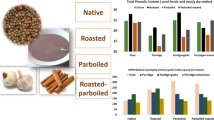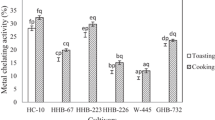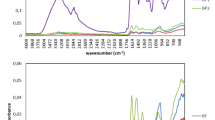Abstract
Even though bean varieties are widely consumed all over the world, data related to how cooking methods and in vitro digestion affect bioactive compounds they contain and data related to bioavailability of polyphenols are limited. The aim of the present study was to investigate how some cooking methods and in vitro digestion influence antioxidant activity, total phenols (TP), and total flavonoids (TF) of widely consumed beans in Turkey. Soaking caused a significant decrease (25.61–38.63%) in the bioavailability of TP of dry common beans (CB). Soaking in cold water resulted in a significant decrease in TP bioavailability of dry pinto beans (PB). TF content was well retained in PB cooked without soaking but was not detected in CB after in vitro digestion. CB soaked in hot water and cooked with the addition of NaHCO3 showed the greatest inhibition effect on 2,2-diphenyl-1-picrylhydrazyl (DPPH) radical (p<0.05). In vitro digestion caused increase in the antioxidant activity of both CB and PB.
Similar content being viewed by others
References
de Almeida Costa GE, da Silva Queiroz-Monici K, Reis SMPM, de Oliveira AC. Chemical composition, dietary fibre, and resistant starch contents of raw and cooked pea, common bean, chickpea, and lentil legumes. Food Chem. 94: 327–330 (2006)
Duranti M. Grain legume proteins and nutraceutical properties. Fitoterapia 77: 67–82 (2006)
Vijayakumari K, Pugalenthi M, Vadivel V. Effect of soaking and hydrothermal processing methods on the levels of antinutrients and in vitro protein digestibility of Bauhinia purpurea L. seeds. Food Chem. 103: 968–975 (2007)
Osorio-Díaz P, Bello-Pérez LA, Agama-Acevedo E, Vargas-Torres A, Tovar J, Paredes-López O. In vitro digestibility and resistant starch content of some industrialized commercial beans (Phaseolus vulgaris L.). Food Chem. 78: 333–337 (2002)
Dueñas M, Hernández T, Estrella I. Assessment of in vitro antioxidant capacity of the seed coat and cotyledon of legumes in relation to their phenolic contents. Food Chem. 98: 95–103 (2006)
Xu BJ, Chang SKC. Effect of soaking, boiling, and steaming on total phenolic content and antioxidant activities of cool season food legumes. Food Chem. 110: 1–13 (2008)
Adebamowo CA, Cho EY, Sampson L, Katan MB, Spiegelman D, Willett WC, Holmes MD. Dietary flavonols and flavonol-rich foods intake and the risk of breast cancer. Int. J. Cancer 114: 628–633 (2005)
Kolonel LN, Hankin JH, Whittemore AS, Wu AH, Gallagher RP, Wilkens LR, John EM, Howe GR, Dreon DM, West DW, Paffenbarger RS. Vegetables fruits legumes and prostate cancer: A multiethnic case-control study. Cancer Epidem. Biomar. 9: 793–804 (2000)
Akillioglu HG, Karakaya S. Effects of heat treatment and in vitro digestion on the angiotensin converting enzyme inhibitory activity of some legume species. Eur. Food Res. Technol. 229: 915–921 (2009)
Jung MJ, Heo S-I, Wang M-H. Free radical scavenging and total phenolic contents from methanolic extracts of Ulmus davidiana. Food Chem. 108: 482–487 (2008)
Saura-Calixto F, Serrano J, Goñi I. Intake and bioaccessibility of total phenols in a whole diet. Food Chem. 101: 492–501 (2007)
Boudet A-M. Evolution and current status of research in phenolic compounds. Phytochemistry 68: 2722–2735 (2007)
Karakaya S. Bioavailability of phenolic compounds. Crit. Rev. Food Sci. 44: 453–464 (2004)
Soobrattee MA, Bahorun T, Neergheen VS, Googoolye K, Aruoma OI. Assessment of the content of phenolics and antioxidant actions of the Rubiaceae, Ebenaceae, Celastraceae, Erythroxylaceae, and Sterculaceae families of Mauritian endemic plants. Toxicol. In Vitro 22: 45–56 (2008)
Gil-Izquierdo A, Zafrilla P, Tomás-Barberán FA. An in vitro method to simulate phenolic compound release from the food matrix in the gastrointestinal tract. Eur. Food Res. Technol. 214: 155–159 (2002)
Xu BJ, Chang SKC. A comparative study on phenolic profiles and antioxidant activities of legumes as affected by extraction solvents. J. Food Sci. 72: 159–166 (2007)
Re R, Pellegrini N, Proteggente A, Pannala A, Yang M, Rice-Evans C. Antioxidant activity applying an improved ABTS radical cation decolorization assay. Free Radical Bio. Med. 26: 1231–1237 (1999)
Llorach R, Martínez-Sánchez A, Tomás-Barberán FA, Gil MI, Ferreres F. Characterisation of polyphenols and antioxidant properties of five lettuce varieties and escarole. Food Chem. 108: 1028–1038 (2008)
Oomah BD, Cardador-Martínez A, Loarca-Piña G. Phenolics and antioxidative activities in common beans (Phaseolus vulgaris L.). J. Sci. Food Agr. 85: 935–942 (2005)
Lin LZ, Harney JM, Pastor-Corrales MS, Lutria DL. The polyphenolic profiles of common bean (Phaseolus vulgaris L.). Food Chem. 107: 399–410 (2008)
Clifford MN. Diet-derived phenols in plasma and tissues and their implications for health. Planta Med. 70: 1103–1114 (2004)
Fardet A, Rock E, Rémésy C. Is the in vitro antioxidant potential of whole-grain cereals and cereal products well reflected in vivo. J. Cereal Sci. 48: 258–276 (2008)
Perez-Jimenez J, Saura-Calixto F. Literature data may underestimate the actual antioxidant capacity of cereals. J. Agr. Food Chem. 53: 5036–5040 (2005)
Liyana-Pathirana CM, Shahidi F. Antioxidant activity of commercial soft and hard wheat (Triticum aestivium L.) as affected by gastric pH conditions. J. Agr. Food Chem. 53: 2433–2440 (2005)
Author information
Authors and Affiliations
Corresponding author
Rights and permissions
About this article
Cite this article
Akillioglu, H.G., Karakaya, S. Changes in total phenols, total flavonoids, and antioxidant activities of common beans and pinto beans after soaking, cooking, and in vitro digestion process. Food Sci Biotechnol 19, 633–639 (2010). https://doi.org/10.1007/s10068-010-0089-8
Received:
Revised:
Accepted:
Published:
Issue Date:
DOI: https://doi.org/10.1007/s10068-010-0089-8




